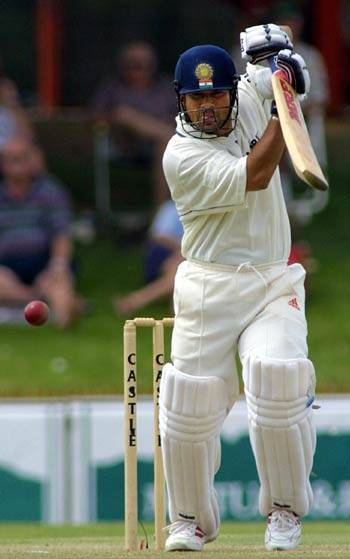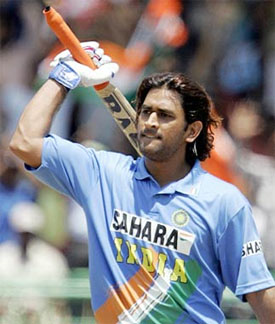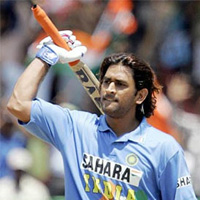Cricket World Cup – A Quadrennial Celebration
Hold your breath! Fasten your seatbelts! The countdown has begun, and cricket fever has gripped the entire world. Even cricket players feel their hearts beating faster than usual as the greatest event in the cricket world is just a few days away! It is no surprise that for fans living in cricket-crazed nations on the Indian sub-continent, euphoria has hit an unbelievable high.
For an ordinary Indian, Pakistani, Bangladeshi, or Sri L ankan, the game of cricket is not just any sport. It is a passion and a religion. In most cases, even more than a religion! The success of the national team can make the entire nation forget its problems and break down into a delirious ecstasy. A failure, on the other hand, can cause law and order problems and can be as serious as any other issue to be discussed in the parliament. But then, gauging the success of India and Pakistan in the World Cup, one may find that out of the eight events held to this date since the first one in 1975, the coveted cup has come to them only twice- India won it way back in 1983 and Pakistan in 1992! But, of course, for the average cricket-lover, these are mere statistics. Their love and passion for the game helps them bury all past failures and disappointments and gives them hope that this time the honor will be theirs for sure!
ankan, the game of cricket is not just any sport. It is a passion and a religion. In most cases, even more than a religion! The success of the national team can make the entire nation forget its problems and break down into a delirious ecstasy. A failure, on the other hand, can cause law and order problems and can be as serious as any other issue to be discussed in the parliament. But then, gauging the success of India and Pakistan in the World Cup, one may find that out of the eight events held to this date since the first one in 1975, the coveted cup has come to them only twice- India won it way back in 1983 and Pakistan in 1992! But, of course, for the average cricket-lover, these are mere statistics. Their love and passion for the game helps them bury all past failures and disappointments and gives them hope that this time the honor will be theirs for sure!
The first one-day international event was played in 1971, on the fifth day of a rain-aborted test match between England and Australia at Melbourne to fill the time, and as compensation for the frustrated crowd. The success and popularity of the domestic one-day competitions in England and other parts of the world as well as the early One-Day Internationals prompted the governing body of International Cricket to consider organising a Cricket World Cup. The event, organised by the International Cricket Council (ICC) and considered to be the most important tournament and the pinnacle of achievement in the sport, was first organised in England in 1975, when the six Test playing nations (England, Australia, New Zealand, West Indies, India and Pakistan) were joined by Sri Lanka and East Africa in the first World Cup. A resounding success, the tournament has taken place every four years since then.
In the inaugural edition, the rampaging West Indies, under the able captaincy of Clive Lloyd, took the honors of defeating Australia in the finals by just 17 runs. The participating eight teams were divided in two groups and the top two teams of the group progressed on to the semis. India, clubbed with England, New Zealand and East Africa, managed to beat only the latter while being thrashed by the English and the Kiwis. In fact, India failed to come to terms with the concept of one-day cricket and possibly considered it as a truncated version of any test match. One of the most interesting highlights of India’s campaign remains the historical innings of the legendary Sunil Gavaskar who made 36 runs, while batting through the innings for 60 overs in the match against England. Pakistan was also eliminated in the group league, having won their outing against Sri Lanka while losing out to West Indies and Australia.
The next World Cup also took place in England in 1979. The West Indies continued their dominance in the world of cricket by registering their second successive success, when Clive Lloyd held aloft the Prudential Cup (named after the sponsors – Prudential), after beating England by 92 runs. The West Indian dream run was initiated by subsequent wins in the group stage against India and New Zealand (the match against Sri Lanka being washed away) and then their triumph over Pakistan in the Semi finals. Pakistan, in comparison to their first outing, had a better performance to display as they reached the semifinals by defeating Australia and Canada in the group stage, even while losing out to England. However, in the semis, gallant batting by Majid Khan (81) and Zaheer Abbas (93) could not help the Pakistani cause against a triumphant West Indies. For India, it was again a rock bottom performance under captain Venkatraghavan, losing all their group matches to West Indies, New Zealand and even to the underdogs, Sri Lanka.
The next World Cup in 1983 was the tournament which shocked the entire cricketing world. Despite being confident of continuing their winning streak in the World Cup, the West Indian juggernaut was stopped midway in the finals by the proponents of one-day cricket – India. At the beginning of the Cup, even the most passionate supporter of India would have shivered at the thought, but Kapil Dev and his men made the miracle a reality. The group stages, which saw a double league for the first time, produced the semi-finalists, England and Pakistan from Group A, and the West Indies and India from Group B. While Pakistan won three of their group matches and lost the same number, India managed to start the series of upsets from the very first game by defeating the defending champions, West Indies, and strong contenders, Australia. Folklore surrounding the World Cup 1983 was due to the outstanding performance of Indian skipper Kapil Dev, who made a scintillating 175 not out against Zimbabwe at a time when India was reeling at 17 for 5. From that point on, there was no looking back. India went on to beat England in the semifinals by six wickets, while West Indies beat Pakistan by eight wickets. In the epic final, Kapil’s boys, especially Madanlal and Mohinder Amarnath, swept the carpet from beneath the feet of the West Indian players by restricting them to 140 against India’s paltry score of 183, thus causing the greatest upset in the history of World Cup. India’s success in the ’83 World Cup catapulted the team into the big league, and the nation was considered to be a force with which to be reckoned.
 The 4th World Cup, the first one to be held outside of England, jointly staged by India and Pakistan, marked the end of West Indian domination in the world of cricket and the emerging power of Australia. Despite being hosts and strong contenders, India and Pakistan failed to cross the semifinal hurdle, and in the end, Australia and England fought for the final. In one of the closely contested finals, Australia came up better off than England by just 7 runs giving captain Allan Border the chance to hold the trophy aloft in Eden Gardens, Kolkata. For India and Pakistan, the start was not bad, as they topped their respective groups winning all but one match out of the scheduled six. India lost to Australia by a solitary run in the opener while the West Indies defeated Pakistan by 28 runs in their last group match. Though the West Indies lost out in the group stages, their paceman Courtney Walsh won the hearts of millions by his sporting gesture of not running out the last Pakistani batsman, ultimately resulting in their ouster.
The 4th World Cup, the first one to be held outside of England, jointly staged by India and Pakistan, marked the end of West Indian domination in the world of cricket and the emerging power of Australia. Despite being hosts and strong contenders, India and Pakistan failed to cross the semifinal hurdle, and in the end, Australia and England fought for the final. In one of the closely contested finals, Australia came up better off than England by just 7 runs giving captain Allan Border the chance to hold the trophy aloft in Eden Gardens, Kolkata. For India and Pakistan, the start was not bad, as they topped their respective groups winning all but one match out of the scheduled six. India lost to Australia by a solitary run in the opener while the West Indies defeated Pakistan by 28 runs in their last group match. Though the West Indies lost out in the group stages, their paceman Courtney Walsh won the hearts of millions by his sporting gesture of not running out the last Pakistani batsman, ultimately resulting in their ouster.
In 1992, the world cup traveled to Australia and New Zealand, bringing a sea of changes. New uniforms, floodlights, white balls, and the highly controversial rain-rule were introduced for the first time as was the return of the South African team. All participating teams were bundled into a single group and made to play each other. India had a horrible series, finishing 7th out of nine teams with just two wins over Zimbabwe and most ironically, Pakistan who was the eventual champion. Despite having a dreadful start and finishing fourth in the group after losing three of their eight matches (West Indies, India and South Africa), Pakistan took the game to new heights under the able leadership of Imran Khan. They toppled New Zealand in the semifinals by four wickets and then stemmed England’s hopes by defeating them in the finals by 22 runs. The main architects of the Pakistani triumph were rookie pace bowler Wasim Akram, veteran batsman Javed Miandad, and of course, captain Imran who led from the beginning and showed the world the greatness of his team. The 1992 World Cup was also remarkable in the aspect that none of the previous champions, West Indies, India, or Australia, made it to the Semifinals.
In 1996, the World Cup was jointly hosted by the South Asian subcontinent countries, India, Sri Lanka and Pakistan. More than the game, the fact that the West Indian and Australian teams refused to play in Sri Lanka due to security concerned dominated the news. As if in a moment of poetic justice, Sri Lanka, eventually went on to win the coveted trophy by defeating Australia in the finals at Lahore. India and Pakistan played in a quarter-final clash, before finishing third and second respectively in their groups. Pakistan lost only to South Africa, while India succumbed to Australia and Sri Lanka. In the high-voltage quarter final match, India thrashed Pakistan by 39 runs to reach the semis. The match at Eden Gardens ultimately had to be awarded to Sri Lanka, even despite crowd disturbances during the event. Sri Lanka, finally, encrypted their dream run into ultimate success during the finals, thanks to an overall great performance by Aravinda D’Silva.
The 1999 World Cup was back on English soil, the birth land of the tournament. Pakistan staged a good performance to reach the finals, but was totally gobbled up by Australia in the finals at Lords by eight wickets. The concept of the top three teams out of a group of six contesting the group’s other top three, known as Super Six, was first introduced in this version. India, though they lost to South Africa and Zimbabwe in the group stage, managed to reach the Super Six where they finished at the bottom, registering a win only against Pakistan. Pakistan, on the other hand, finished their group at the top, after an upset loss against minnows Bangladesh, and also went on the Super Six stage, despite losing to India and South Africa. They decimated New Zealand in the semifinals by nine wickets, before getting paid back in the same coin by Australia in the finals.
The latest edition was held in South Africa in 2003, where one saw the defeated Indian team was suddenly rejuvenated by a wave of the magic wand after their first match loss to Australia. It seemed that the Saurav Ganguly-led team demolished everything that came in their path until they were brought to the ground again by the Australians in the finals. Before reaching the finals, India finished second in their group, defeating all but Australia and Pakistan. Pakistan again failed to live up expectation and was eliminated in the group stage, losing three of their six matches. India won all their matches in the Super Six and set up a clash against surprise contestant, Kenya, who through sheer luck and a stunning win against Sri Lanka managed to reach the last four. However, Captain Ganguly and Master Blaster Tendulkar’s rampaging batting cut short Kenyan hopes, though in the finals, it was India who was made to bite the dust by Australia who routed them by 125 runs.
Now, it is 2007, and the venue is the West Indies. It is time for the 9th edition of this hugely popular tournament. The stage is set and participating teams are making fine tunings to their team composition and strategies for the 45-day quadrennial tournament. There has been a new format designed for this event, and for the first time, 16 teams will be participating. The tournament will begin with a league stage consisting of four groups of four teams each. Each team will play each of the other teams in its group once. The top two teams in each group will proceed to the “Super 8” stage, which is a variation from the previous Super Six system. This will also use a league system. Each team will carry forward its result against the qualifying team from its own preliminary stage group and will play the other six qualifying teams once each. The top four teams in the league will qualify for the semi-finals. The finals will be played in Barbados on April 28, 2007.
India has been placed in Group B with Sri Lanka, Bangladesh and ICC qualifiers Bermuda. Pakistan is in group D with host West Indies, Zimbabwe and Ireland. India begins their campaign against Bangladesh on March 17, 2007, in the Port of Spain while Pakistan plays West Indies in Jamaica in the first match of the tournament on March 13, 2007. Most probably, India and Pakistan will meet during the Super 8 stage. Most interestingly, Pakistan has never been successful in defeating India in a World Cup match to this point.
While the ultimate objective of all the participating teams will be to win the World Cup, their foremost task will be to stop the Australian juggernaut from vying for the championship. Indeed, on the point of possibilities, Australia stands on one side, while the other teams rest on the other. India and Pakistan certainly possess the potential to challenge Australian supremacy along with South Africa, West Indies and Sri Lanka, but then the teams’ top guns have to perform consistently. Though the teams are yet to be finalized, it is expected that India will be powered by Sachin Tendulkar, Sourav Ganguly, Rahul Dravid, M.S. Dhoni, and Yuvraj Singh in their batting department, while Zaheer Khan, Harbhajan Singh, and Anil Kumble will add to the bowling firepower. Pakistan will depend heavily on Mohd. Yousof, captain Inzamam ul Haque, Shahid Afridi and Younis Khan for willow power, while their bowling department will most probably be taken care of by Mohd Sami, Razzaq and Naved-ul-Rana and if available, the deadly Shohaib Akhtar.
It is certain that both these teams have the capacity to win a game on their own merit and bedazzle their opponents on any given day. Now, whether they actually perform on D-Day is the question millions of spectators are asking. Whichever team wins, India, Pakistan, Australia or South Africa, the ICC World Cup 2007 is going to be spectacular display of cricketing talents that sports lovers will remember for many days to come.



























